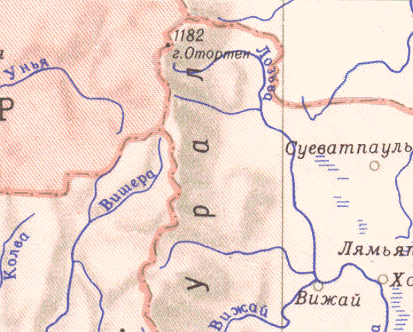URAL
MOUNTAINS, 1959
The name, Otorten, in translation from Mansi language means
"Mountain of the dead men..."
A 1959 case report from Russia graciously reported and translated for us by Michael Trachtengerts in Moscow. His letter reads as follows:
"I translated
for you my letter to my friend and former participant of Moscow Crypto
Seminar, Mr. Ilya Treyger. He lives now in Denver. Colorado and has own
Internet site. He placed this letter in Russian in it.
The address of the page is: http://russdenver.www6.50megs.com/trachtengerts.html
I suppose it may be
interesting to you. The style of a private letter remained. If you have
questions about any part of the letter or situation I readily answer you.
I also reproduced for you a piece
of map with Otorten Mountain to locate the place. Michael Trachtengerts,
Moscow
- ---
Hi, Ilya!
Now I wish to tell you something that'll be interesting to you. (In English)
You probably know about a strange old incident when a group of tourists
was found dead in a ski tour on Ural in 1959. The leader of the group
was Djatlov.
It was the case, when at a terrible night all skiers were frightened by something unknown and in obvious panic had rushed out of their tent. They cut the walls of their tents with knives and ran from the camp in different ways. They all were found dead near the camp without body damages and with the stiffened horror on their faces. No footsteps of another persons or big animals were found.
There was police investigation and expeditions of rescue rangers but not any reasonable explanation was proposed. Rumours about UFO and the like were discussed among tourists. But nothing was clear till now.
In 1999, Vadim Chernobrov, who explores such phenomena, was there and has made a short report to our seminar. He received access to materials of the investigation and to the certificates of postmortem examinations. He conversed with those who participated in the investigation of this strange case. He found out the real happening was somewhat different from what was told later by generations of tourists.
Till February 1, 1959 the group continued its way as usual in habitual order. It's interesting that many of tourists had diaries and daily wrote down their own impressions. These diaries were found but there was nothing in them that showed menace for the guys. They contained only different details of life during the trek. On February 1st they came to Otorten Mountain that is rather flat and suitable for easy climb on skis. According to the plan of the trek they had to climb it.
 The
name, Otorten, in translation from Mansi language means "Mountain
of the dead men", and the native people try to avoid visiting
the place. It's located in upper parts of Pechora River at a joint of
borders of Sverdlovsk, Perm, and Tyumen Provinces and Komi Republic.
The
name, Otorten, in translation from Mansi language means "Mountain
of the dead men", and the native people try to avoid visiting
the place. It's located in upper parts of Pechora River at a joint of
borders of Sverdlovsk, Perm, and Tyumen Provinces and Komi Republic.
But on February 1st some strange things appeared in behaviour of the group as police investigation had revealed. They had stopped to camp much earlier, than usually. The people had put tents one km from top only and in 1,5 km from edge of a forest on an entirely open place. The group without problems could pass this day on the mountaintop and stay in forest with firewood as usual. That day nobody wrote in diaries, but for some unknown reason they unwrapped the large sheet of paper and wrote on it in upper part by the large letters such words: "From now on we know that the snow men exist".
The inspectors have decided that the group didn't feel quite themselves and have started to make wallpaper for their club, not waiting for the end of the trek. They were sure that the guys named themselves as "snow men" as they were very strong winter travelers.
Ilya, please recollect that in that time snowmen stories came only from the Himalayas and none from Soviet Union with the only message by hydrologist Pronin at Pamir. Nobody could think about hominoid at Polar circle, and official persons especially!
Now, Vadim Chernobrov knew much more about hominoids than anybody did in those times and he viewed the situation anew.
From the certificates of postmortem examinations he'd found out that three from all nine men had their ribs fractured. They were damaged symmetrically on right and left parts of the bodies and without externally visible impacts. As though a very strong someone had embraced them. It is obvious that these men had real reason for horror.
As to absence of traces, after February 1st strong winds blew and the snow was blown off and its level had lowered by 25 centimeters. Instead of usual deep traces chains of small hillocks of pressed snow led from the tent in different directions. It's possible that elevations of hard snow from huge hominoid footsteps were not understood as such and were considered as stones or something else that stood out of snow.
In addition to said above Chernobrov found out that in 1958 year a group of Mansi hunters were lost mysteriously near the Otorten Mountains. In general, this place became known as very menacing and nobody from native people wished to go there.
I didn't find in this
hypothesis anything that would contradict our modern knowledge about hominoids
in Taiga Regions."
- ---
Report courtesy
of Dr. Michael Trachtengerts, Ph.D., Moscow.
Back to Stories
Back to Bigfoot Encounters Main page
Back to Newspaper & Magazine Articles
Back to Bigfoot Encounters "What's New" page